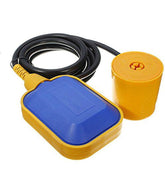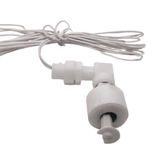Float Switch - How they Work
Summary
Dive into the fascinating world of float switches with our blog, "Float Switch - How they Work." Discover the basics in our Introduction, unraveling the mystery behind these ingenious devices. Explore How Float Switches Work, delving into their key components and understanding the science that makes them tick. Learn about Factors in Choosing the Right Float Switch to ensure you make the perfect selection. Uncover Common Problems and Troubleshooting tips to keep your system running smoothly. Don't miss the crucial insights on Installing Float Switches for optimal performance. Join us on this journey, culminating in a compelling CONCLUSION that ties it all together. Click in for a float-switching adventure!
Introduction
A float switch is a ingenious device utilized across numerous applications to monitor and automatically regulate liquid levels. The operating principle involves a floater object that moves vertically within a chamber in response to fluctuating liquid surfaces. This vertical motion triggers the activation or deactivation of an integrated switch which completes or breaks an electrical connection that controls a correlated system. Common usages include automatic turn on/off of sump pumps, bilge pumps, cooling tanks, waste water systems, stormwater harvesting, controlling valves, low liquid level warnings, and more. Reliable and versatile, float switches confer autonomous functionality tailored to unique specifications.

How Float Switches Work
Several components work in conjunction to enable float switches to sense liquid levels and exert system control. The basic mechanism entails a specially designed float object housed within a hermetic switch chamber and connected to the interior switch apparatus.


As surrounding liquid levels rise or fall, the attached float travels vertically within the confines of the chamber. Buoyant materials such as copolymer plastic, stainless steel, or magnetic assemblies are commonly utilized as floats. The choice of material determines the sensitivity, durability, and compatibility with monitored liquids. During fluctuating conditions, the float's movement triggers the switch to alternate between open or closed electrical states depending on orientation. Most function through simple mechanical contact where the rising float makes physical contact with the switch lever, thereby flipping it on or off. This elicits a binary electrical output that serves as a signal to external pumps, valves, alarms or other affiliated equipment. This ON/OFF switching capability in response to liquid level changes enables automated monitoring and control.
Additionally, floats may be shaped and weighted to specification in order to set narrow operational parameters tailored to individual applications. Carefully calibrating the floats sensitivity to movement ensures the switch engages only once liquid surfaces pass a minimum or maximum threshold level. Such custom engineered designs prevent premature or false activations. Hence, discerning industrial applications can implement floats and control parameters aligned to their operational requirements.
The switch itself is commonly a standard pole single throw (SPST) type with varying amperage ratings to accommodate affiliating electrical loads. Connecting wires relay this basic open/closed circuit signal to the electrical components under control. This rudimentary yet versatile concept establishes the foundation for automatic liquid level control in countless systems.
Key Components
- Housing - The water-tight housing encapsulates the entire internal switching mechanism. This safeguards inner components while providing mounting means onto liquid storage vessels. Commonly constructed from durable ABS or polycarbonate plastic. Some models feature hooped bands or external brackets to ease installation onto tanks and piping manifolds.
- Float - As described previously, the float couples vertical movement with switch activation. Myriad float configurations exist. Spherical, rod, and paddle shapes with custom composite weighting at one end to optimize rotational balancing. This facilitates smooth vertical travel with minimal turbulence. Common substances include copolymer plastics for corrosion resistance, foam floats for buoyancy, stainless steel for durability and chemical tanks, or magnetic elements for sensing precise liquid densities.
- Switch - The switch establishes or disrupts electrical signal transmission to external components commanding operational states. Basic SPST (single-pole/single-throw) type switches featuring varying ampere ratings up to 15+ amps and 115-250 VAC compatibility. Advanced models incorporate mercury or snap-action switches for rapid sensing capability. Switch mounts connect to the floats body to enable direct physical contact when liquid levels shift float positions.
- Mounting - Robust mounting provisions like threaded ports or bottom brackets allow fixed installation onto pump housings, chamber walls, and tank interiors where liquid monitoring is required. This also maintains the float switch at a proper orientation to enable unencumbered operation. Some implementations feature brackets or screws with adjustable heights to position switches at precise depths for specialized applications. Proper static and dynamic mountings are essential for longevity and performance.
Factors in Choosing the Right Float Switch
Selecting an appropriate float switch for a given application requires assessing operational conditions and specifying a tailored configuration. Key factors include:
- Pump/Tank Size & Voltage - Appropriately rating switch load capacities to affiliate pump/valve sizes prevents electrical overloading. Higher amperage ratings commonly denote larger power equipment and higher voltages. Choosing switches designed for corresponding loads enhances safety and performance.
- Liquid Properties - Liquid temperature, viscosity, and chemistry influence equipment selection. Industrial acids, sewage, high temperature recirculation lines, and corrosive chemicals necessitate durable pH/temp resistant housing and float elements able to withstand associated conditions.
- Adjustment Range - Applications with variable liquid volumes often mandate vertical adjustability for positioning switches at precise depths. Robust mounting brackets with height adjustment slots feature on select models to accommodate dynamic conditions. Fixed depth alternatives exist for reservoirs with constant depths.
- Size & Shape - Space constraints within small tanks and tight piping complexes restrict large components. Compact float switch profiles maintain modest footprints. Low-profile designs occupy shallow liquid layers while smaller spherical floats operate even in constricted containers. Custom shape/density floats suit unique implementations.
With numerous configurations available spanning size, chemical resistance, mounting versatility, power ratings, and sensitivity calibration - there exists a tailored float switch solution for most applications. Identifying key operational conditions and specifications facilitates appropriate selections.
Common Problems and Troubleshooting
While largely durable, issues infrequently occur with float switches. Isolating and correcting common problems restores automated functionality. Potential issues include:
- Switch Failure - If floats traverse properly without initiating equipment, switch contacts may be oxidized or degraded. Replacing outdated switches returns operation. Match amperage ratings appropriately.
- Debris Fouling - Particulates sometimes penetrate seals jamming or weighting floats. Cleaning/replacing restores buoyancy. Installing secondary coarse strainers upstream mitigates reoccurrance.
- Incorrect Wiring - Inadequate connections interrupting control signal transmission prevents affiliated equipment response despite floats activating. Revisiting wiring diagrams and validating circuits aids diagnosis.
Carefully examining symptoms guides troubleshooting. Temporary float switch overrides help isolate specific faults before assessing fixes. Remember to de-energize power sources beforehand as a safety precaution during examinations.
Installing Float Switches

Once appropriately sized float switches are selected, they must be oriented and mounted securely within associated tanks/reservoirs. Reliable installation is essential for optimized performance. Common techniques include:
- Tank Mounting - External screw threads situated along the housing exterior provide attachment points to secure switches vertically at specified liquid depths. Positioning them at minimum/maximum allowable levels tailors control activation setpoints. Bracket configurations vary amongst hardware.
- Piping & Fitting Integration - Pipe-mounted configurations involve embedding into piping complexes adjacent reservoirs. Holed clamps or brackets anchor the switches aligning float axes perpendicular to flow. Ensures rising liquid encounters floats directly without laminar bypass. Useful for stormwater drains.
- Wiring - Electrical termination varies amongst hardware. Consult wiring schematics for switch live/neutral/ground connections paired with pump/valve units under control. Use analog voltmeters to validate circuit continuity transitions between open and closed switch states during testing.
Judiciously installing float switches following manufacturer guidelines ensures they interface with corresponding equipment appropriately. This culminates in automated systems functioning seamlessly through harsh conditions for extended durations. Periodic servicing and replacement of outdated switches maintains regulated performance.
Conclusion
Float switches constitute an ingenious mechatronic innovation that automates liquid level control across numerous industrial and commercial applications. Their widespread adoption testifies to the durability and reliability centering these devices for nearly a century. Carefully considered selection, installation, and maintenance culminates in years of consistent service.
A variety of customization options exists spanning size specifications, durability grades, and sensitivity tuning to tailor them to unique applications. Additional switch pairings allow expanded monitoring and control - deploying multiple floats at graduated depths enables tiered activation of separate devices across a range of liquid levels. This facilitates everything from cascading flood alarms to staggered pump operation.
Future technological improvements will further diversify applicability along with precision and capabilities - but the fundamental concept persists. Float switches endure as an indispensable tool for automated liquid level control. Their straightforward design and operation conceals remarkable utility benefitting numerous domains. Any application involving automated liquid transfer, monitoring, or processing can leverage them to confer functionality, safety, and autonomous supervision.






